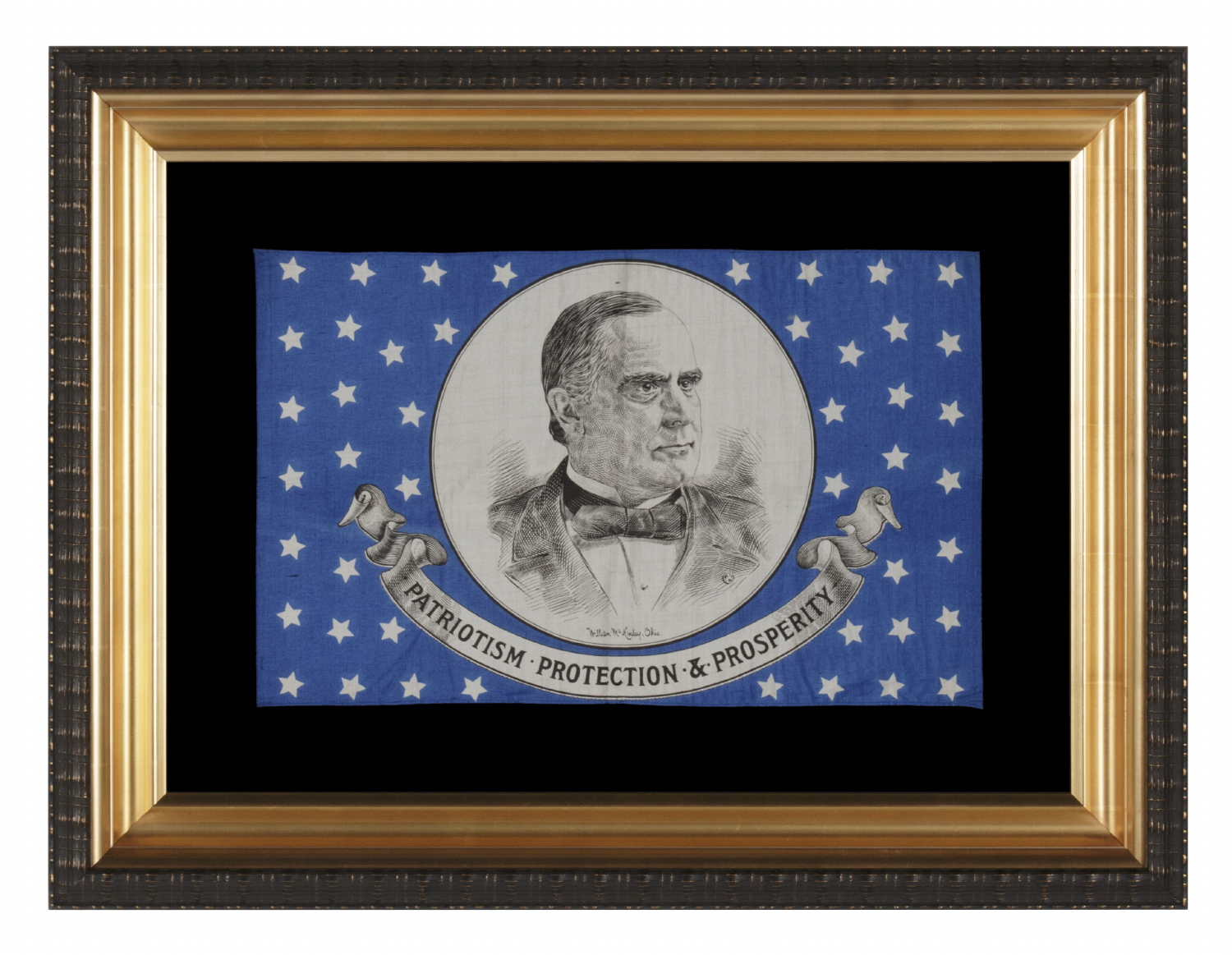
| |
SILK PARADE FLAG WITH 46 STARS ON A STRIKING, ROYAL BLUE GROUND, MADE FOR THE 1900 PRESIDENTIAL CAMPAIGN OF WILLIAM McKINLEY, FEATURING A LARGE PORTRAIT AND A GREAT SLOGAN |
|
| Available: |
Sold |
| Frame Size (H x L): |
21.75" x 28.5" |
| Flag Size (H x L): |
11.5" x 18" |
|
| Description....: |
|
Campaign parade flag, printed on silk, made for the 1900 presidential run of incumbent William McKinley, when he ran and won a second term with Vice Presidential Candidate Theodore Roosevelt. Set upon a brilliant, royal blue ground with white stars, the design features an especially well-executed and handsome portrait of our nation's 25th president. Pictured in black tie attire, this is situated within a round window and captioned by his name and home state in calligraphic script: "William McKinley, Ohio." Cradling the medallion image is a billowing streamer with the Republican Party slogan: "Patriotism, Protection, & Prosperity."
Stylistically the flag is unique among known varieties. Devoid of stripes, it mimics the United States Navy's Union Jack, (more commonly referred to as simply the "jack,") flown when a ship was at port or anchored. President McKinley had just steered America to victory in the Spanish-American War (1898), but whether or not this design suggested any sort of Navy relationship remains unknown. Whatever the case may be, another factor was driving presidential candidates away from use of the Stars & Stripes as a billboard. The printing of names and portraits on the Stars & Stripes, perfectly acceptable through much of the 19th century, was becoming unpopular. In the latter 1880's there was a growing shift in public opinion to uphold the flag as a more sacred object, worthy of a greater ethics surrounding its use and display. Attempts were made to ban the use of the flag for advertising in 1890 and 1895, but it was not until the year 1905 that Congress finally decreed that the use of text or portraits on official insignia of the United States would afterwards be outlawed. The practice fell out of favor before this date, however, to such a degree that both politicians and flag-makers largely abandoned the practice for the 1888 election and by 1900 it was virtually eradicated.
Another notable feature is the flag's count of 46 stars, which officially post-dated not only the 1900 election, but the entirety of the 1901-1904 presidential term. On the surface this may seem concerning, but in practice it was in no way unexpected. Flag makers cared little about official star counts, producing what they felt would best appeal to potential flag buyers. America was bent on Westward Expansion. Adding stars before states had even joined was commonplace. The earliest documented example of an "anticipatory" star count in political campaign parade flags actually appeared more than 50 years prior, in 1844, on a style of flag made for pro-expansionist president James Polk in advocation of Texas statehood.
The 45 star flag was official throughout the entirety of McKinley's two campaigns and presidencies. Utah had entered the Union as the 45th state on January 4th, 1896, the official addition of the 45th star occurred on July 4th of that same year. [Following the Flag Act of 1818, stars were officially added on Independence Day following a state's addition.] Oklahoma obtained statehood on November 16th, 1907 and the 46th star was formally added on July 4th, 1908. So the 46th star on this McKinley flag, advocating Oklahoma statehood, was being added eight years before his successor, Teddy Roosevelt, would actually usher it into the Union.
Based up fabric and colors, and similarity to other examples, I expect that this flag was produced by the Cheney Silk Manufacturing Company (1855-1955) of Manchester, Connecticut, one of the nation’s largest silk manufacturers.
Mounting: The flag was mounted and framed within our own conservation department, which is led by masters degree trained staff. We take great care in the mounting and preservation of flags and have framed thousands of examples.
The mount was placed in a gilded French molding with a traditional American profile, to which a ripple profile molding, black with gold highlights, was added as a cap. The glazing is U.V. protective plexiglass.
Condition: One tiny hole in the background of the white medallion. The overall condition is extraordinary . |
|
|
|
| Collector Level: |
Intermediate-Level Collectors and Special Gifts |
|
| Flag Type: |
Parade flag |
|
| Star Count: |
46 |
|
| Earliest Date of Origin: |
1900 |
|
| Latest Date of Origin: |
1900 |
|
| State/Affiliation: |
Oklahoma |
|
| War Association: |
|
|
| Price: |
SOLD |
|
| |
Views: 1770 |
|
|
|

